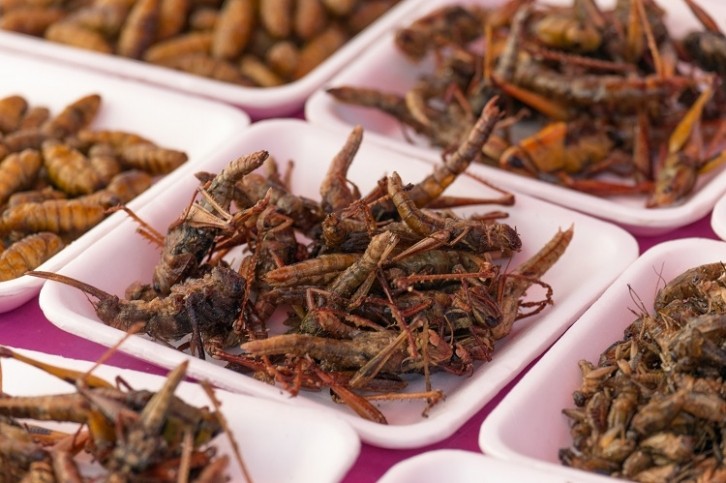‘Insects will be seen as normal food’: How industry is combatting consumer reluctance to eat insect protein
With a growing consensus among many in the food industry around the necessity to diversify protein sources – rather than rely on meat alone – we are, in the view of many, seeing the beginnings of a ‘protein transition.’
The view of this transition is mixed: some see it as a shift towards a diet of purely plant-based protein, while others include within the concept the transition toward insect proteins.
Insect proteins have many advantages, from an environmental perspective, over cattle. According to the World Economic Forum (WEF), insect farming requires lower levels of land and water use, and a 2010 study suggested that insects are connected to around 1% of the GHG emissions compared to that of ruminants. Furthermore, they are also often very high in protein, with crickets, according to one researcher, containing nearly three times the protein content of beef.
The big challenge is not getting them to market, but ensuring they stay there. Many consumers are reluctant to consume insect protein: a study found out last year that consumers’ disgust is one of the main barriers to insect consumption, with food neophobia being another.
A study later in the year cemented this by showing that those consumers who were more familiar with insect proteins were more likely to give them a try. A fear of the new, it seems, is the main driver of reluctance, with an increase in familiarity mitigating this.
With a growing number of start-ups marketing insect proteins, how are they combatting perception challenges and persuading consumers they’re worth a shot?
Persuading consumers to stop worrying and love the insect
Accepting insect protein consumption has been described as ‘the triumph of science over irrationality’ by the International Platform for Food and Feed (IPFF). Consuming insects is, according to the platform, backed by science.
Food Neophobia
Neophobia combines ‘neo’, meaning new, and ‘phobia’, meaning fear. Essentially, neophobia is a fear of the new.
Several studies have found that many consumers, at least in countries considered part of the ‘western world’, experience food neophobia when consuming insects, because of their novelty to the market.
Encouraging shoppers to consume is not always easy, however. For insect protein start-ups catering to humans rather than animals, combatting this reluctance is a major goal.
“To lead them to diversify their daily protein consumption and truly make insects a part of their diet, it is necessary to start with educating the populations. This education involves demonstrating the health benefits of insect consumption, as well as its water and land efficiency,” Antoine Hubert, co-founder & chief strategy officer at French company Ÿnsect, told FoodNavigator. Ÿnsect produces insect proteins for plants, pets and, most importantly, humans. Its protein can be used as an ingredient.
Meanwhile, Switzerland-based Essento provides insect protein in more familiar forms: snack bars, flours, and even burgers.
“Since we started back in 2013 the consumer reluctance has very much decreased,” Essento CEO and founder Christian Bärtsch told FoodNavigator. According to Bärtsch, consumers were pleasantly surprised by the taste when trying it in a supermarket. “We figured that products with processed insects (minced or as powder) are easier adopted. Plus over time we have seen that rate of inclusion of meals is going up.”
Utilising familiarity is, as studies have shown, an important part of appealing to the consumer. “It is a familiar product with a familiar taste, just the main ingredient (the animal protein) has a different source and the insects are processed and not detectable/visible.”
Insects in the world
Outside of what many define as the ‘west’ – Europe, North America and parts of Oceania – food neophobia around insects is not necessary to combat, as consumers are already familiar with insects as food there.
For example, a significant proportion of men from Latin America and Asia eat insects on a daily basis. ”These dietary habits are currently distant from those of us in the West. However, they also serve as evidence that habits can change and evolve over time, driven by societal, environmental, and even economic changes,” Ÿnsect’s Hubert told us.

As Hubert points out, even within the ‘west’, consumption habits already vary from country to country. “Sushi or pizza are excellent examples since they vary based on the countries where they are consumed. We, westerners, are not yet ready to find whole insects on supermarket shelves. That’s why we are developing our ingredients, which can then be incorporated into recipes,” he said.
“Eating habits and traditions change over long time and so insects will sooner or later be seen as ‘normal food’ as it has happened with sushi or lobster.”
“At a time when food and environmental issues can no longer be ignored, we must find solutions to reinvent our global food systems to make them healthier, more natural, and sustainable. It is clear that, in doing so, we can draw inspiration from the practices of our neighbours while culturally adapting them.”
While in other parts of the world, people may eat whole insects, Hubert suggests culturally adapting them in order to fit Western preferences, for example using them as ingredients.
Much like Hubert, Essento’s Bärtsch emphasises the success of previous processes of normalisation for once-novel products, suggesting insect protein could go the same way.
Insect welfare
Whether the minds of insects are complex enough for their suffering to be morally relevant is a question for the philosophers, but both start-ups make efforts to improve insect welfare in the farming process.
“When it comes to farming insects, our farms use the blanching process, which is according to the Swiss animal welfare and studies the current know least-harmful process, as it only takes a fraction of a second for the insects to die. Insects are farmed in mid-large colonies in a dark and warm surrounding which reflects their preferred natural habitat,” Essento’s Christian Bärtsch told FoodNavigator.
Ÿnsect, too, aims to provide the best conditions for its insects, according to Antoine Hubert, “whether in the selection of our insect (gregarious, non-flying, lives in the dark), in terms of animal nutrition and health, or in the definition, implementation, and monitoring of our processes (AI, Robotics). In our vertical farms, we implement all measures to raise our insects under the best conditions.”
“Due to globalisation and traveling, traditions and eating habits have spread around the globe as well and some people have encountered insects as food while traveling. Eating habits and traditions change over long time and so insects will sooner or later be seen as ‘normal food’ as it has happened with sushi or lobster,” he told us.
How does insect protein compare to plant-based meat
As a replacement for animal protein, insect proteins have one chief rival: plant-based meat. While the latter has obvious advantages, such as being suitable for vegetarians and vegans, insect protein also provides certain key benefits for consumers that plant-based meat does not.
“We often say that insect protein brings together the best of both worlds: as sustainable as plant-based protein but as nutritious as animal protein.”
“We often say that insect protein brings together the best of both worlds: as sustainable as plant-based protein but as nutritious as animal protein. Indeed, it contains essential amino acids, but its cultivation has a much lower impact on the environment and biodiversity. In this regard, we have the ambition to reinvent the food chain: to find alternatives that allow us to feed the planet while limiting the impact of livestock on resources,” Hubert told us.
“Some insects are a complete and high-quality protein source (offering all essential amino acids) and as an animal protein have a high absorption rate. Plus, it comes along with a broad set of other nutritionals that our bodies need to function,” Bärtsch added.
Sourced From: Food Quality and Preference
‘Effectiveness of nudge interventions to promote fruit and vegetables’ selection, purchase, or consumption: A systematic review’
Published on: 26 January 2024
Doi: https://doi.org/10.1016/j.foodqual.2024.105122
Authors: C. Almeida, J. Azevedo, A. Fogel, E. Lopes, C. Vale, P. Padrão



